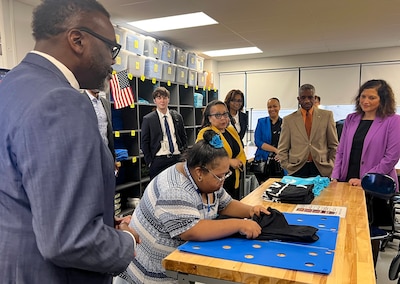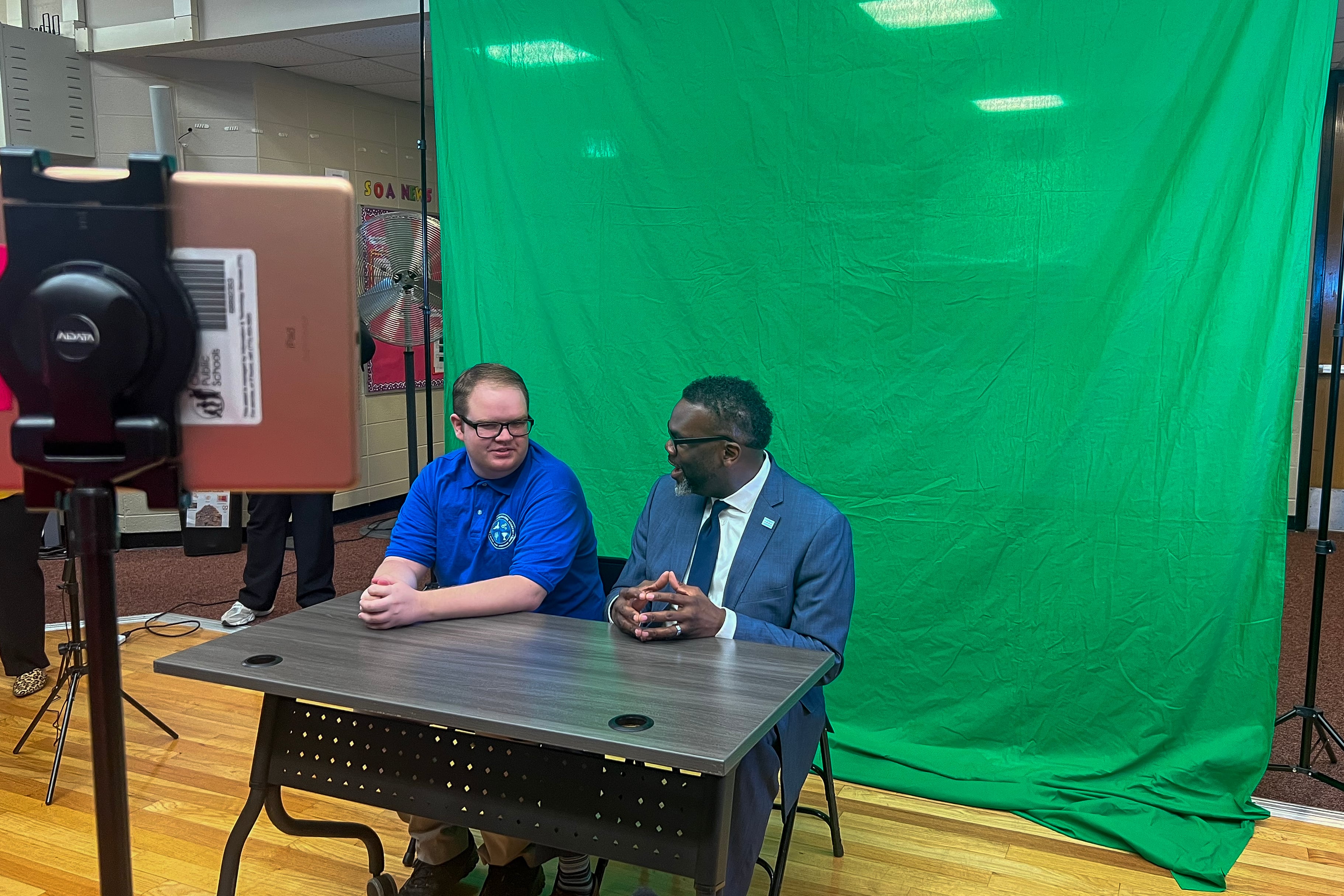Mary Fahey Hughes, a member of Chicago’s Board of Education, went into mom mode Monday during a tour of her son’s former South Side school, which provides work and life skills training to older students with disabilities.
Standing to the side of a horticulture classroom at Southside Occupational Academy High School, Hughes smiled as she snapped photos of Aidan next to Mayor Brandon Johnson, who was also on the tour. Aidan has come far from when he was diagnosed with autism as a child — and Hughes was unsure what his future would look like, she said.
She credits the Englewood school — from which Aidan graduated in June — with giving him the confidence to chat up the mayor and show off his alma mater.
“He just gained so much independence,” Hughes said in a hallway at Southside. “The thing I love about this place is there is so much respect for students where they’re at.”
Chicago Public Schools officials are considering expanding the model at Southside and a handful of other so-called specialty schools, which are meant to help students with more challenging disabilities transition into the real world, Chicago Public Schools CEO Pedro Martinez said Monday.
Monday’s tour was the district’s opportunity to show off the model to Johnson and a slew of other city and district officials. If the district decides to grow the program, it would need to lobby the state for more funding, Martinez said.
“We’re having the conversation internally about, how do we look at these programs, build on their strengths and potentially expand them,” Martinez said.
The district has seven specialty schools that together enroll about 1,800 students with mild to moderate cognitive disabilities, said Sylvia Barragan, a spokesperson for Chicago Public Schools. Three schools are early childhood programs that serve younger students with disabilities. The remaining four — including Southside — are for older students and have a focus on vocational and life skills.
Unlike traditional high schools, the district assigns students to these schools, Barragan said.
Some students with disabilities who look for work after graduation may benefit more from going through a specialty program first, Martinez said. He believes the need is enough to warrant doubling the number of specialty schools.
Other districts, such as New York City, have similar programs where students with disabilities learn vocational skills.
These programs, however, have drawn some criticism for segregating students with disabilities, instead of allowing students to build skills next to peers who don’t have a diagnosed disability.
Southside Principal Joshua Long has said his school model allows students to have the specialized attention they need.
At Southside, nearly 88% of students came from low-income families last year. Asked if schools like Southside limit students to low-paying jobs, Hughes said the programs hone skills that these young adults may otherwise miss out on, potentially leaving them stuck at home without work. Hughes noted that the schools serve students with a variety of strengths, and some graduates go on to community college.
“The problem is that a lot of jobs are low-paying, despite the amount of work that needs to get done,” Hughes said.
High school students can attend Vaughn Occupational High School and Northside Learning Center High School, both on the Northwest Side. Southside, in Englewood, and Ray Graham Training Center, in the South Loop, serve students who have met graduation requirements but still need “transition supports and services,” as determined by the team that creates their Individualized Education Program, according to the district. At these two schools, students are typically ages 18-22.
At Southside, where 360 students enrolled last year, students learn about various potential jobs and responsibilities they will need in the real world. Most students are exposed to every class, and some do internships, such as with the Museum of Science and Industry, said Kristen Dimas, a teacher at the school.
Long led the mayor and other officials through several different rooms that simulate a different career or life responsibility. Among the classrooms they saw were a horticulture class, a mock grocery store, a broadcast studio with a green screen, a garage where students learn to wash cars, and a café — complete with a bakery display case.
A group of students stopped by the horticulture room to ask if they had laundry. They would eventually go to the laundry room, where they learn how to wash clothes but also learn a mental checklist on basic hygiene.
“Smell your armpits. Do they smell fresh?” said a laminated list in the laundry room. “If not, put on deodorant.”
In a supply room, where a laminated document listed rules for folding a T-shirt, a student carefully practiced folding. Long gently asked her to get the mayor’s T-shirt size, but the student was shy. The mayor, who used to be a teacher, ultimately revealed he’s an extra large.

“But here’s the thing — you don’t have to tell everybody that,” he said to the student, who laughed and handed him a T-shirt.
The café and laundry classes are favorites of 18-year-old Josiah Hall, who enrolled at Southside in August. He especially enjoys spending time with the teachers, he said. He hopes to attend a four-year university, such as the University of Illinois at Urbana-Champaign.
The school works to help students understand the career options that are right for them and to reach those goals, Long said.
For Aidan, Hughes’ son, that path has led to a new transition program for adults age 18 and older at Daley College. He’s also taking EMT classes and dreams one day of being a firefighter like his father.
Correction: Sept. 26, 2023: A previous version of this story said the program at Daley College is for people age 22 and older. It is for people age 18 and older.
Reema Amin is a reporter covering Chicago Public Schools. Contact Reema at ramin@chalkbeat.org.






